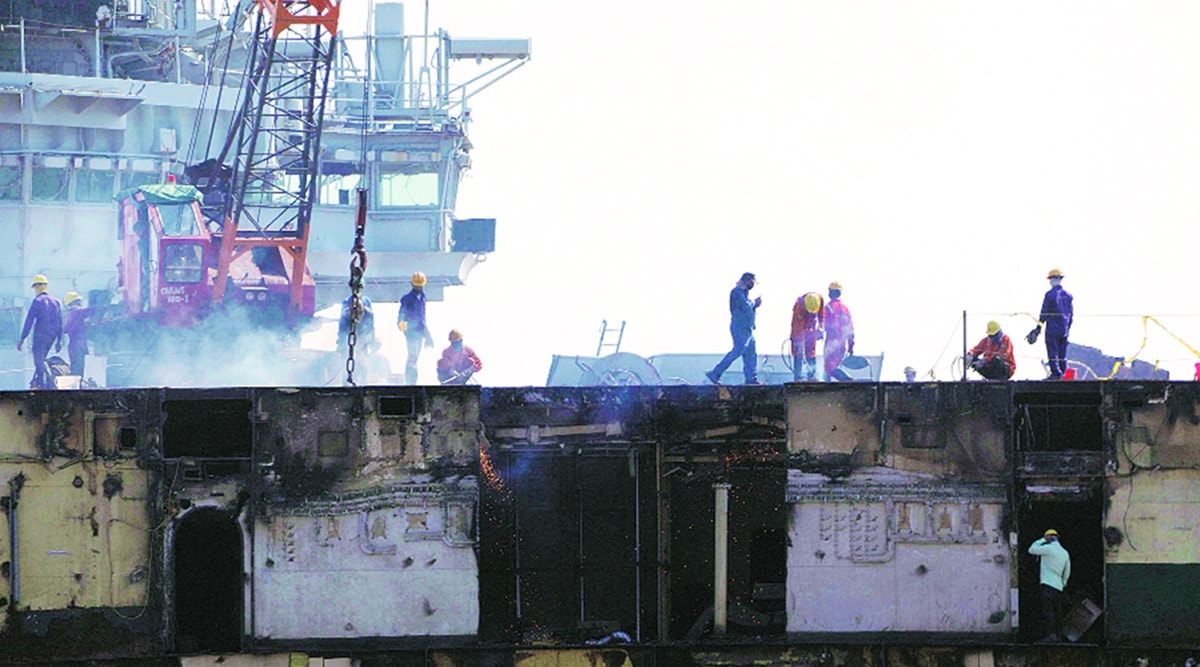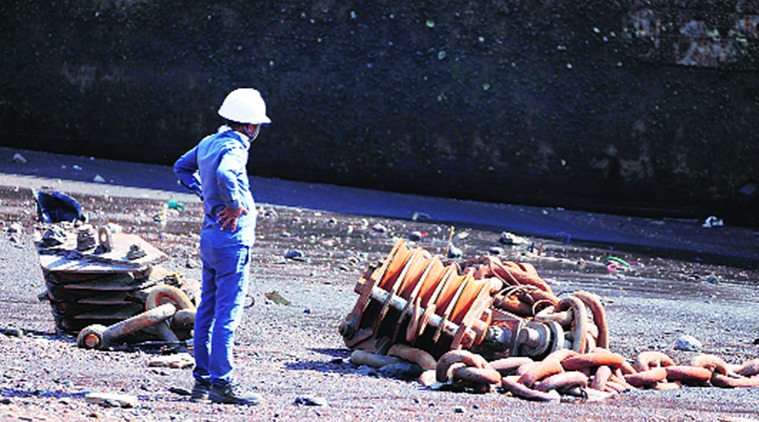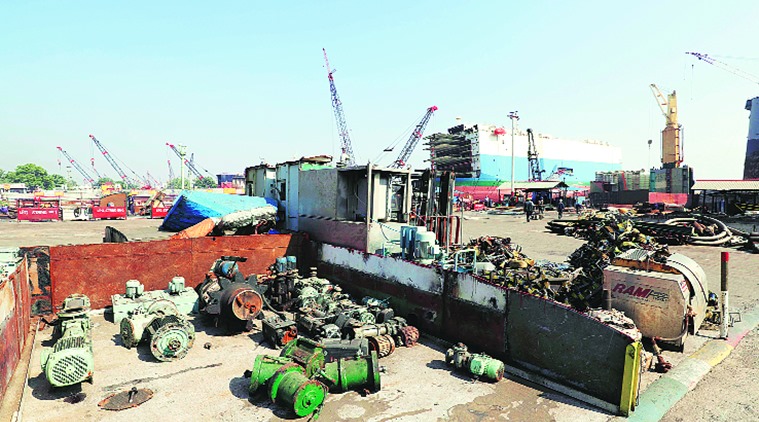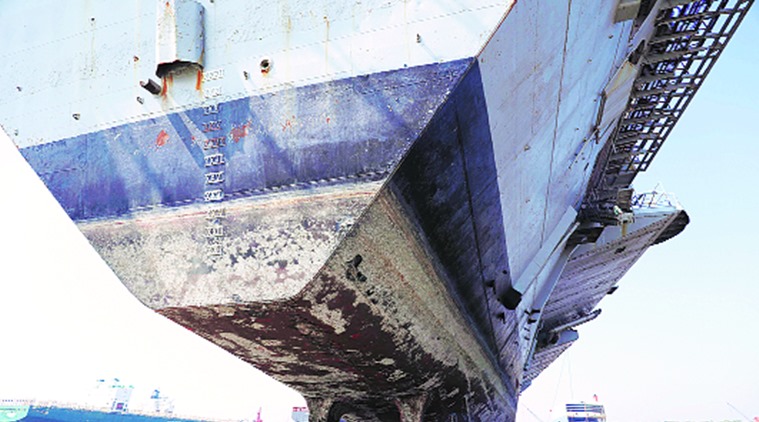INS Viraat has seen the Falklands War in 1982 as the flagship vessel for the British Navy (1959-84) and also guarded the Indian coasts for 30 years
ONCE POPULATED by fierce Sea Harriers that scanned the ocean for potential enemies, the partially broken flight deck of INS Viraat now hosts a red 30-tonne crane that is helping dismantle India’s iconic aircraft carrier at Alang shipbreaking yard in Gujarat.
It has been nearly six weeks since this crane was dismantled and ported on the empty flight deck to be reassembled again to help break down the battleship, piece by piece, with the help of gas cutters. “About 25 per cent of the vessel has been cut,” says Mukesh Patel, chairman of Shree Ram Group that bought the vessel at an auction held by the government-owned Metal Scrap Corporation Limited for Rs 38.54 crore.
The first portion of the vessel was cut and lifted by the crane on December 1, 2020. Some 50-odd labourers have been staying on the ship since last month, as it is anchored almost 300 feet away from the beach on plot number nine of the ship-breaking yard.
INS Viraat has seen the Falklands War in 1982 as the flagship vessel for the British Navy (1959-84) and also guarded the Indian coasts for 30 years. As the water ebbs, twice daily the hull of the ship, sunk in mud, is exposed along with the chains and the iron ropes that fasten the ship to sea-facing diesel winches which have been slowing trying to pull it ashore ever since it arrived in Alang on September 28 last year.
Over the last one month, workers have cut open the ski jump — an upward curved ramp, angled at 12 degree — that was used countless times by the Sea Harriers, a naval jet fighter, reconnaissance and attack aircraft, that once populated INS Viraat along with Westland Sea King, Dhruv and Chetak helicopters. The rear portion of the vessel has also been cut. “This has been done to maintain the vessel’s balance,” says Patel.
Memorabilia
The two anchors of INS Viraat were the first items to be salvaged from the “Grand Old Lady” decommissioned by the Indian Navy on March 6, 2017, which the Shree Ram Group plans to display on its plot.
“After all, she shares a history with Britain and India,” says Jinay Patel, a family member of Mukesh Patel and the in-charge of cutting operations of INS Viraat.
On July 2016, INS Viraat sailed from Mumbai to Kochi for the last time on her own steam. By then, she had spent 2,252 days at sea, sailing 5.88 lakh nautical miles, which was almost equivalent to covering the globe 27 times. In Kochi, she underwent a deactivation programme and her engines, propellers and rudders were removed. She was later towed to Mumbai for the decommissioning ceremony.
“The ship was completely stripped when we got its possession. The steering wheel, ship’s bell, embossed nameplates, and any item of value was salvaged by the Indian Navy. We, as a family, retained the spoons and knives embossed with the INS Viraat logo. We have gifted this cutlery to different family members. There was nothing else we could have retained,” says Jinay, who had also participated in the bidding for INS Viraat. The weapon systems and operational equipment were removed by mid-2017.
Cutting down the ship
Before the cutting began, manholes were cut into the body of the ship to allow any trapped gases to escape and to allow sunlight to penetrate.
“This is important for those cutting the vessel as we do not have much artificial light on board and any trapped gases can lead to an explosion when gas torches are lighted for cutting,” says Sanjeev Singh, a safety officer who is in charge of the safety of the aircraft carrier.
Singh, who hails from Kolkata, is in constant touch with the supervisors on the vessel. The 22-year-old says certain markings are also done on the vessel beforehand to guide workers during the cutting process. “At night, we have to position guards on the oil rig and on the vessel to ensure there is no attempt to steal. After all, this is a historic vessel,” he adds.
A part of the documentation process of the INS Viraat’s dismantling, the Shree Ram Group has been video recording the entire process every single day from a camera that hangs by a crane on the plot. “The ship has nine decks in total. Four are above the flight deck, which also consists of the ship’s bridge and accommodations. This portion contains the identification of the vessel (R22), Motto (Jalameva Yasya, Balameva Tasya) and logos of the air squadrons painted on it. Five decks located below the flight deck include the gallery and hangar deck where aircrafts used to be stationed within the ship,” says Singh.
“It is important to maintain the stability of any floating vessel, even when it is being dismantled. The naval architect, whom we have hired, will help us ensure that the ship continues to remain upright as we winch it in,” says Batuk Patel, elder brother of Mukesh Patel and father of Jinay.
In the coming days, as the ship is winched near the beach, more workers will be hired to work on the battleship. A 120-tonne crane is also being readied to help lift larger parts being cut from the vessel.
“Unlike other ships, we do not have any detailed records of INS Viraat. Even basic documents have not been shared for security reasons. We are learning as we are cutting the ship down and towards the end, we will know her better,” says Batuk.
Experience with Clemenceau
Though the Shree Ram Group has dismantled a couple of smaller vessels in the past, this is the first time that the shipbreaker is handling an aircraft carrier. The first brush the shipbreaker had with an aircraft carrier was in 2005-06 when the Shree Ram Group was embroiled in a controversy after buying the decommissioned French aircraft carrier, Clemenceau, which was claimed to be containing large amounts of asbestos. The 27,000-tonne French warship was recalled midway to Alang by the then French President Jacques Chirac.
The experience with Clemenceau, the shipbreaker says, is coming in handy while dealing with INS Viraat. “The first large naval vessel we bought was Clemenceau. That project had to be scrapped. However, seven team members from Shree Ram Group had travelled to France to get training on how to handle the naval vessel. We had done specialisation on asbestos removal during the training of about 15 days. This experience is coming in handy now,” says Jinay. Shree Ram Group had also bid for INS Vikrant, which was broken down in Mumbai.
The shipbreakers are also documenting the dismantling of the ship. They are not only keeping a record of the dismantling process but also installed a camera on a crane that looks out to the sea to document the everyday process on the ship.
Hopes for a museum fade
In September 2020, when INS Viraat arrived at Alang it came it as a “dead vessel”. It had no propellers or power in its engines to help it beach on the shores. A tug boat had helped it undertake the final journey before it ran aground 3,000 feet from the shore.
Union Shipping Minister Mansukh Mandaviya and Rear Admiral Puruvir Das, Flag Officer Commanding, Gujarat Naval Area of the Indian Navy, were present at the event “Thank You Viraat” organised by the shipbreaker where Mandaviya had said a fast-rusting hull and dangers of an accident prevented the Modi government from spending Rs 500 crore in helping convert it into a museum.
Several attempts were also made by different state governments, including Maharashtra, Andhra Pradesh and Goa, to ensure that INS Viraat does not meet the fate of INS Vikrant, which was broken down in Mumbai in 2014.
In July 2019, the Modi government informed Parliament of its decision to scrap INS Viraat. The decision was taken after the vessel could not be handed over to any state government because of lack of “self-sustaining and financially complete” proposal to preserve the vessel.
Once the INS Viraat reached Alang, there was one final attempt made by little-known Envitech Marine Consultants Pvt Ltd. The company, however, could not enter into a deal with the Alang shipbreaker after Rs 100 crore was sought for the vessel along with a no-objection certificate from the Centre. The firm could not produce either the money or the permission from the government.
“We are running a business here. We could not have waited longer. We were ready to hand over the historic vessel to anyone who wanted it. All we demanded was a formal agreement and permission from the government as we had bought the vessel as scrap,” says Mukesh Patel, chairman of Shree Ram Group. The firm had waited for almost three months before winching the vessel towards the shoreline.
“We had conducted a laboratory test on the metal scrapped from the ship and it is the same mild steel plate which is used in different ships. There is nothing special despite the battleship being built way back in the 1940s. When any ship is cut, 90-92 per cent is mild steel,” says Batuk.
What has been salvaged
Cupboards, steel beds used by sailors, tables, desks, and doors are a few of the things that have been salvaged from INS Viraat and stacked up across the open plot. Blowers, lights, starters, electrical panels, and motors have also been retrieved from the aircraft carrier, which was first commissioned as HMS Hermes in November 1959. These lie on the plot where the vessel is being broken.
The shipbreaker, however, is excited about the metal scrap prices rising to Rs 30 per kilogramme from the Rs 25 that existed during the pre-Covid era. “I clean and cut, if necessary, whatever comes out of the ship. Though most of what has come out till now are all rusted, I sometimes wonder about the soldiers who rode and fought on this battleship,” says Naresh Jadhav, a helper while hammering down a metal part salvaged from the battleship that used to carry 26 combat aircraft and was deployed for Sri Lankan Peace Keeping Force operations in 1969 and Operation Parakaram, following the 2001 terrorist attack on the Indian parliament.
Source: Read Full Article







